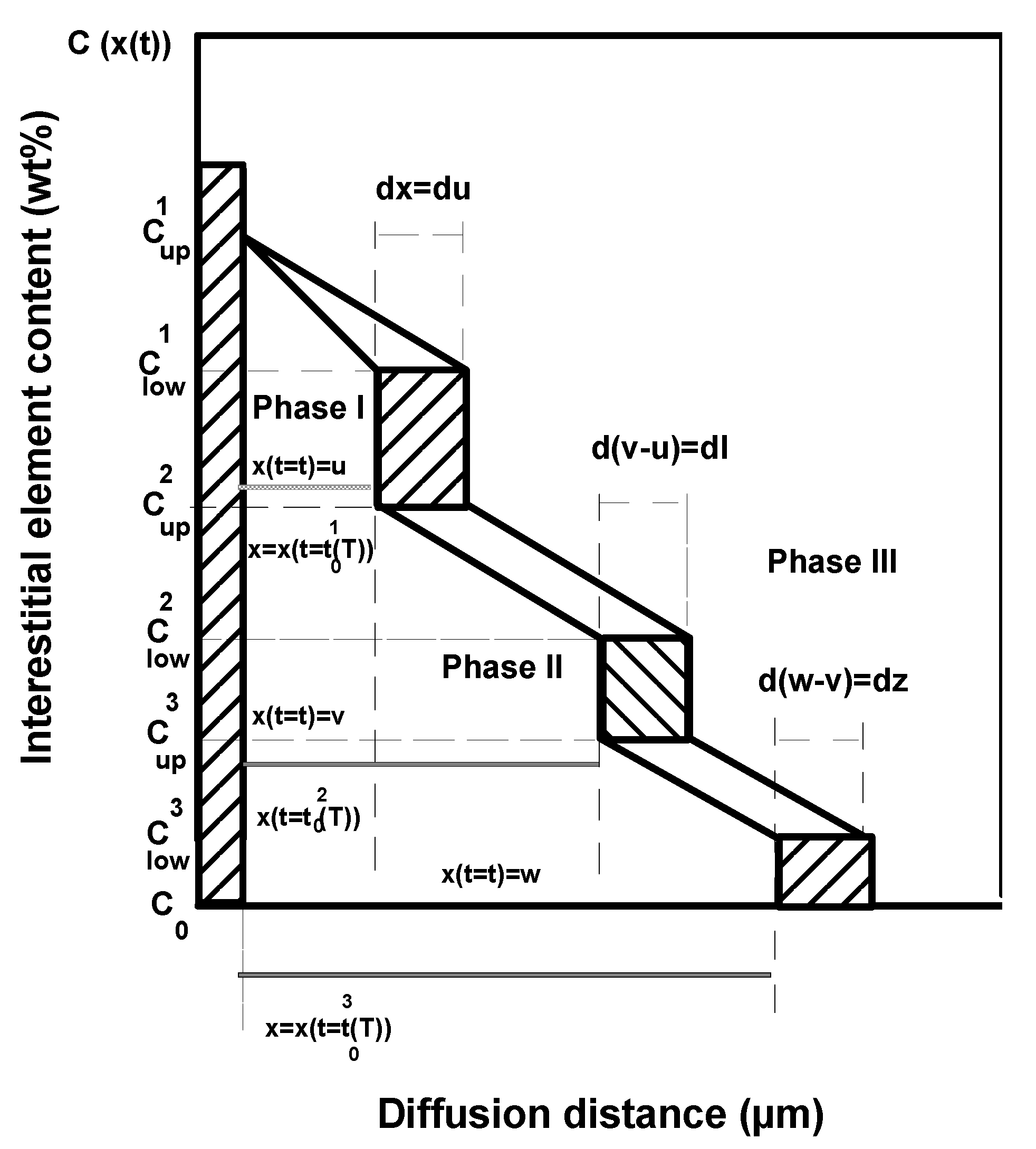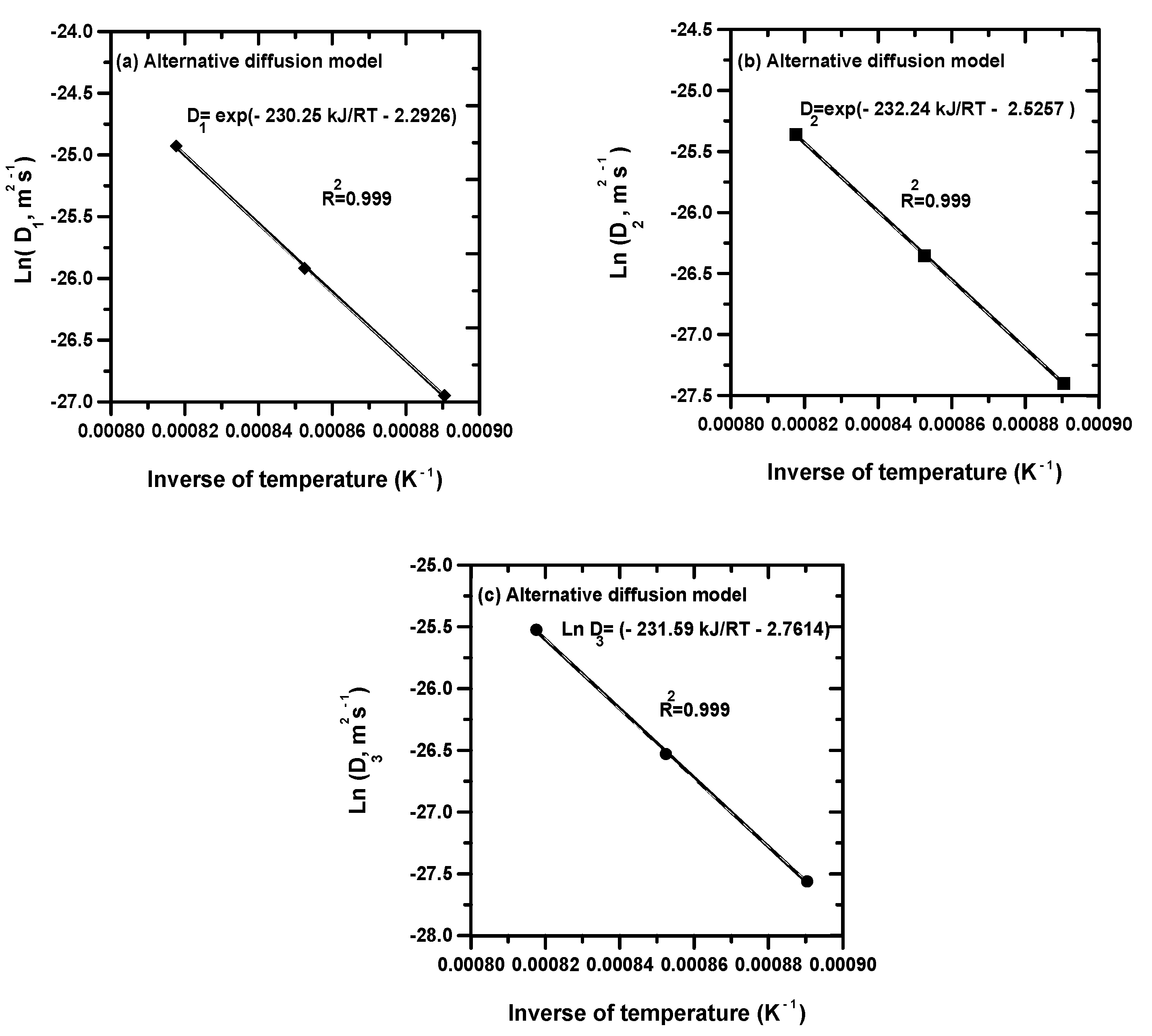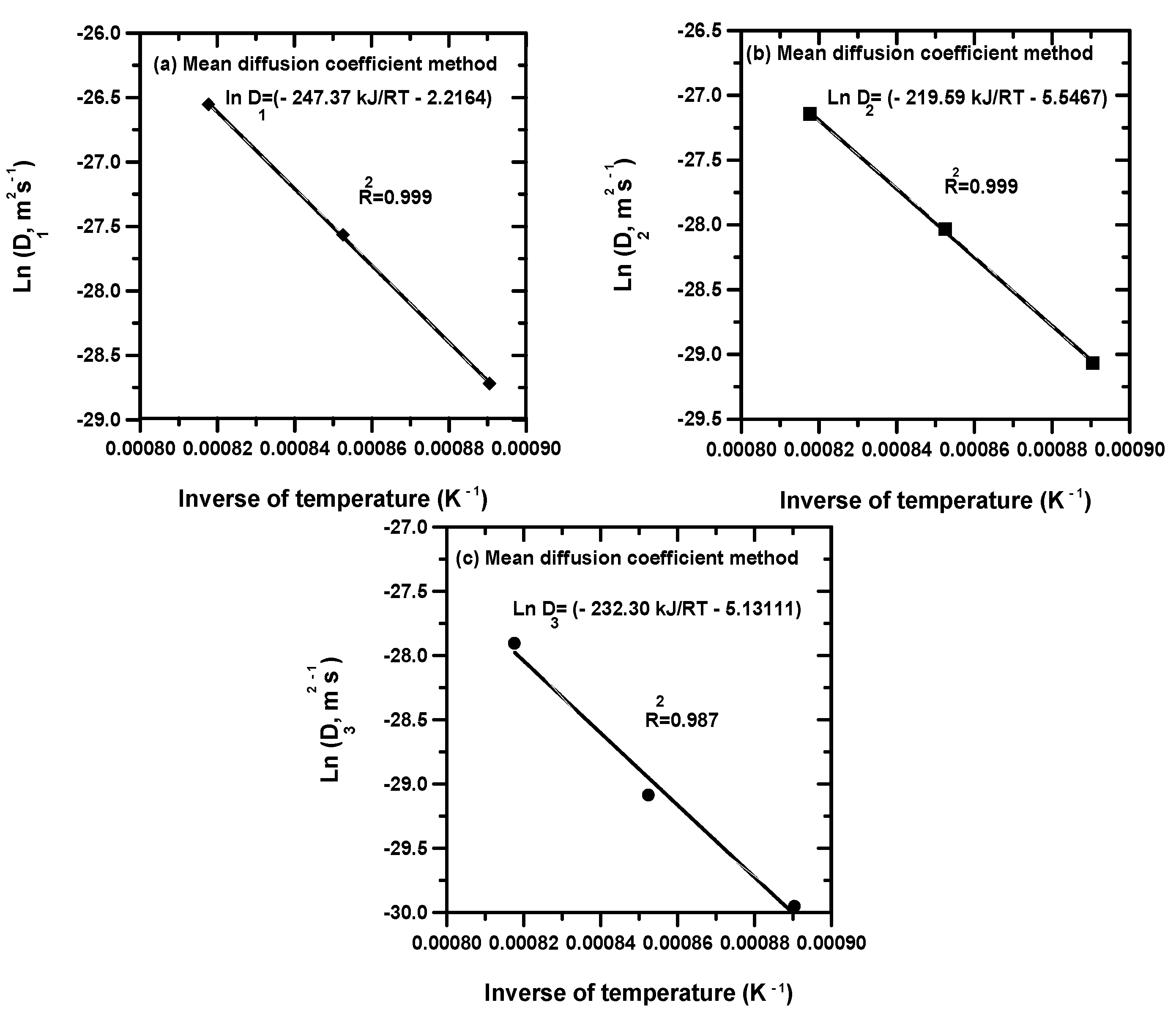Assessment of Boron Diffusivities in Nickel Borides by Two Mathematical Approaches
Abstract
:1. Introduction
2. The two Diffusion Models
2.1. First Approach: The Alternative Diffusion Model
2.2. Second Approach: The Mean Diffusion Coefficient Method
3. Simulation Results and Discussions
3.1. Estimation of Boron Diffusivities in Nickel Borides
3.2. Comparing the Values of Boron Activation with Those Found in the Literature
4. Conclusions
Author Contributions
Funding
Institutional Review Board Statement
Informed Consent Statement
Data Availability Statement
Conflicts of Interest
References
- Ayvaz, S.I.; Aydin, I. Effect of the Microwave Heating on Diffusion Kinetics and Mechanical Properties of Borides in AISI 316L. Trans. Indian Inst. Met. 2020, 73, 2635–2644. [Google Scholar] [CrossRef]
- Azouani, O.; Keddam, M.; Allaoui, O.; Sehisseh, A. Characterization of boride coatings on a ductile cast iron. Prot. Met. Phys. Chem. Surfaces 2017, 53, 306–311. [Google Scholar] [CrossRef]
- Türkmen, I.; Yalamaç, E. Effect of Alternative Boronizing Mixtures on Boride Layer and Tribological Behaviour of Boronized SAE 1020 Steel. Met. Mater. Int. 2021, 1–15. [Google Scholar] [CrossRef]
- Fang, H.M.; Zhang, G.S.; Xia, L.S. Properties and Growth Kinetics of the Boride Layer of a Boriding-Strengthened Fe-Based Powder Metallurgical Material. Strength Mater. 2021, 53, 65–72. [Google Scholar] [CrossRef]
- Elias-Espinosa, M.; Ortiz-Domínguez, M.; Keddam, M.; Gómez-Vargas, O.A.; Flores, A.A.; Barrientos-Hernández, F.R.; West, A.R.; Sinclair, D.C. Boriding kinetics and mechanical behaviour of AISI O1 steel. Surf. Eng. 2015, 31, 588–597. [Google Scholar] [CrossRef]
- Günen, A.; Keddam, M.; Erdoğan, A.; Karakaş, M.S. Pack-Boriding of Monel 400: Microstructural Characterization and Boriding Kinetics. Met. Mater. Int. 2021. [Google Scholar] [CrossRef]
- Campos-Silva, I.; Vega-Morón, R.C.; Reséndiz-Calderón, C.D.; Bravo-Bárcenas, D.; Eryilmaz, O.L.; Kahvecioglu-Feridun, O.; Rodríguez-Castro, G. Dry Sliding Wear Resistance of Cobalt Boride Coatings Formed on ASTM F1537 Alloy. J. Mater. Eng. Perform. 2019, 28, 2399–2410. [Google Scholar] [CrossRef]
- Keddam, M.; Makuch, N.; Boumaali, B.; Piasecki, A.; Miklaszewski, A.; Kulka, A. Liquid Boriding of Cp-Ti and Ti6Al4V Alloy: Characterization of Boride Layers and Tribological Properties. Surf. Engin. Appl. Electrochem. 2020, 56, 348–357. [Google Scholar] [CrossRef]
- Akca, B.; Çalık, A. Characterization of borided pure molybdenum under controlled atmosphere. Prot. Met. Phys. Chem. Surf. 2017, 53, 511–517. [Google Scholar] [CrossRef]
- Usta, M.; Ozbek, I.; Ipek, M.; Bindal, C.; Ucisik, A. The characterization of borided pure tungsten. Surf. Coat. Technol. 2005, 194, 330–334. [Google Scholar] [CrossRef]
- Tarakci, M.; Gencer, Y.; Calik, A. The pack-boronizing of pure vanadium under a controlled atmosphere. Appl. Surf. Sci. 2010, 256, 7612–7618. [Google Scholar] [CrossRef]
- Contla-Pacheco, A.; Keddam, M.; Lartundo-Rojas, L.; Ortega-Avilés, M.; Mejía-Caballero, I.; Campos-Silva, I. Application of the Heat Balance Integral Method to the growth kinetics of nickel boride layers on an Inconel 718 superalloy. Surf. Coat. Technol. 2021, 420, 127355. [Google Scholar] [CrossRef]
- Kulka, M. Trends in Thermochemical Techniques of Boriding. In Current Trends in Boriding; Springer: Cham, Switzerland, 2018; pp. 17–98. [Google Scholar]
- Makuch, N. Influence of nickel silicides presence on hardness, elastic modulus and fracture toughness of gas-borided layer produced on Nisil-alloy. Trans. Nonferrous Met. Soc. China 2021, 31, 764–778. [Google Scholar] [CrossRef]
- Campos-Silva, I.; Ortiz-Domínguez, M.; López-Perrusquia, N.; Meneses-Amador, A.; Escobar-Galindo, R.; Martínez-Trinidad, J. Characterization of AISI 4140 borided steels. Appl. Surf. Sci. 2010, 256, 2372–2379. [Google Scholar] [CrossRef]
- Campos-Silva, I.; Franco-Raudales, O.; Meda-Campaña, J.A.; Espino-Cortes, F.P.; Acosta-Pavón, J.C. Growth Kinetics of CoB–Co2B Layers Using the Powder-Pack Boriding Process Assisted by a Direct Current Field. High Temp. Mater. Process. 2019, 38, 158–167. [Google Scholar] [CrossRef]
- Anthymidis, K.; Stergioudis, E.; Tsipas, D. Boriding in a fluidized bed reactor. Mater. Lett. 2001, 51, 156–160. [Google Scholar] [CrossRef]
- Cabeo, E.R.; Laudien, G.; Biemer, S.; Rie, K.-T.; Hoppe, S. Plasma-assisted boriding of industrial components in a pulsed d.c. glow discharge. Surf. Coat. Technol. 1999, 116–119, 229–233. [Google Scholar] [CrossRef]
- Keddam, M.; Taktak, S. Characterization and diffusion model for the titanium boride layers formed on the Ti6Al4V alloy by plasma paste boriding. Appl. Surf. Sci. 2017, 399, 229–236. [Google Scholar] [CrossRef]
- Jain, V.; Sundararajan, G. Influence of the pack thickness of the boronizing mixture on the boriding of steel. Surf. Coat. Technol. 2002, 149, 21–26. [Google Scholar] [CrossRef]
- D’Souza, B.; Leong, A.; Yang, Q.; Zhang, J. Corrosion behavior of boronized nickel-based alloys in the molten chloride Salt. Corros. Sci. 2021, 182, 109285. [Google Scholar] [CrossRef]
- Predel, B. B-Ni (Boron-Nickel). In Landolt-Börnstein-Group IV Physical Chemistry; Springer: Berlin/Heidelberg, Germany, 2012; p. 61. [Google Scholar]
- Gunes, I.; Keddam, M.; Chegroune, R.; Ozcatal, M. Growth kinetics of boride layers formed on 99.0% purity nickel. Bull. Mater. Sci. 2015, 38, 1113–1118. [Google Scholar] [CrossRef]
- Yildiz, I.; Çelik, A.G.; Gunes, I. Characterization and Diffusion Kinetics of borided Ni–Mg Alloys. Prot. Met. Phys. Chem. Surf. 2020, 56, 1015–1022. [Google Scholar] [CrossRef]
- Makuch, N.; Dziarski, P.; Kulka, M.; Keddam, M. Growth Kinetics and Some Mechanical Properties of Plasma Paste Borided Layers Produced on Nimonic 80A-Alloy. Materials 2021, 14, 5146. [Google Scholar] [CrossRef] [PubMed]
- Campos-Silva, I.; Hernández-Ramirez, E.; Contreras-Hernández, A.; Rosales-Lopez, J.; Valdez-Zayas, E.; Mejía-Caballero, I.; Martínez-Trinidad, J. Pulsed-DC powder-pack boriding: Growth kinetics of boride layers on an AISI 316 L stainless steel and Inconel 718 superalloy. Surf. Coat. Technol. 2021, 421, 127404. [Google Scholar] [CrossRef]
- Nait Abdellah, Z.; Keddam, M.; Jurči, U. Simulation of boronizing kinetics of ASTM A36 steel with the alternative kinetic model and the integral method. Koroze a Ochr. Mater. 2021, 65, 33–39. [Google Scholar] [CrossRef]
- Keddam, M.; Jurči, P. Alternative Kinetic Model of Growth of Boride Layers on Steel AISI 316. Met. Sci. Heat Treat. 2021, 63, 430–436. [Google Scholar] [CrossRef]
- Keddam, M.; Kulka, M. Mean Diffusion Coefficient Method in Studying Armco Iron Boriding Kinetics. Met. Sci. Heat Treat. 2020, 62, 326–330. [Google Scholar] [CrossRef]
- Boumaali, B.; Nait Abdellah, Z.; Keddam, M. Computer simulation of boronizing kinetics for a TB2 alloy. Mater. Test. 2021, 63, 1130–1135. [Google Scholar] [CrossRef]
- Kahvecioglu, O.; Sista, V.; Eryilmaz, O.; Erdemir, A.; Timur, S. Ultra-fast boriding of nickel aluminide. Thin Solid Films 2011, 520, 1575–1581. [Google Scholar] [CrossRef]
- Torun, O. Boriding of nickel aluminide. Surf. Coat. Technol. 2008, 202, 3549–3554. [Google Scholar] [CrossRef]



| T (K) | at the First Interface | at the Second Interface | at the Third Interface |
|---|---|---|---|
| 1123 | 5.51 | 12.06 | 15.60 |
| 1173 | 10.21 | 21.10 | 26.10 |
| 1223 | 17.12 | 33.31 | 43.15 |
| T (K) | |||
|---|---|---|---|
| 1123 | 0.8830 | 0.9090 | 0.9190 |
| 1173 | 0.8920 | 0.9320 | 0.9690 |
| 1223 | 0.9110 | 0.9330 | 0.9780 |
| T (K) | D1 | D2 | D3 |
|---|---|---|---|
| 1123 | 1.98 | 1.26 | 1.07 |
| 1173 | 5.54 | 3.59 | 3.00 |
| 1223 | 14.93 | 9.69 | 8.20 |
| T (K) | D1 | D2 | D3 |
|---|---|---|---|
| 1123 | 3.37 | 2.38 | 0.98 |
| 1173 | 10.68 | 6.70 | 2.33 |
| 1223 | 29.39 | 16.29 | 7.59 |
| Alloy | Boriding Process | Temperature Range (K) | Phases of the Boronized Layer | Activation Energies (kJ mol−1) | Method Used | Refs. |
|---|---|---|---|---|---|---|
| Monel 400 | Powder | 1123–1273 | Ni2B | 300.7 | Integral method | [6] |
| Inconel 718 | Powder | 1123–1223 | Cr2B, Ni2B, Ni3B, Ni4B3 | 233.20 (Ni4B3) 206.17 (Ni2B) 218.06 (Ni3B) | Integral method | [12] |
| Nickel 201 | Powder | 1123–1223 | NiB, Ni2B, Ni3B, Ni4B3 | 203.87 | Empirical relation | [23] |
| Ni-Mg at 3 and 7 wt% Mg | Powder | 1173–1273 | NiB, Ni2B, Ni3B | 58.843 for 3 wt% Mg 136.506 for 7 wt% Mg | Empirical relation | [24] |
| Nimonic 80 A | Plasma paste Boriding | 1023–1123 | NiB, Ni2B, Ni3B, Ni4B3 | 190.93 | Integral method | [25] |
| Inconel 718 | Pulsed-DC powder | 1123–1223 | Ni4B3, Ni2B, Fe2B, Cr2B | 153 for the bilayer 159 for the diffusion zone | Bilayer model | [26] |
| Ni3Al | Electrochemical | 1073–1223 | Ni3B, Ni4B3, Ni20AlB14 | 185.95 | Empirical relation | [31] |
| Ni3Al | Powder | 1073–1223 | Ni3B, Ni4B3, Ni3Al | 188 ± 14.4 | Empirical relation | [32] |
| Inconel 718 | Powder | 1123–1223 | Ni2B, Ni3B, Ni4B3 | 230.25 (Ni4B3) 232.24 (Ni2B) 231.59 (Ni3B) | Alternative diffusion model | This work |
| 247.37 (Ni4B3) 219.59 (Ni2B) 232.30 (Ni3B) | MDC method |
Publisher’s Note: MDPI stays neutral with regard to jurisdictional claims in published maps and institutional affiliations. |
© 2022 by the authors. Licensee MDPI, Basel, Switzerland. This article is an open access article distributed under the terms and conditions of the Creative Commons Attribution (CC BY) license (https://creativecommons.org/licenses/by/4.0/).
Share and Cite
Keddam, M.; Jurči, P. Assessment of Boron Diffusivities in Nickel Borides by Two Mathematical Approaches. Materials 2022, 15, 555. https://doi.org/10.3390/ma15020555
Keddam M, Jurči P. Assessment of Boron Diffusivities in Nickel Borides by Two Mathematical Approaches. Materials. 2022; 15(2):555. https://doi.org/10.3390/ma15020555
Chicago/Turabian StyleKeddam, Mourad, and Peter Jurči. 2022. "Assessment of Boron Diffusivities in Nickel Borides by Two Mathematical Approaches" Materials 15, no. 2: 555. https://doi.org/10.3390/ma15020555
APA StyleKeddam, M., & Jurči, P. (2022). Assessment of Boron Diffusivities in Nickel Borides by Two Mathematical Approaches. Materials, 15(2), 555. https://doi.org/10.3390/ma15020555







